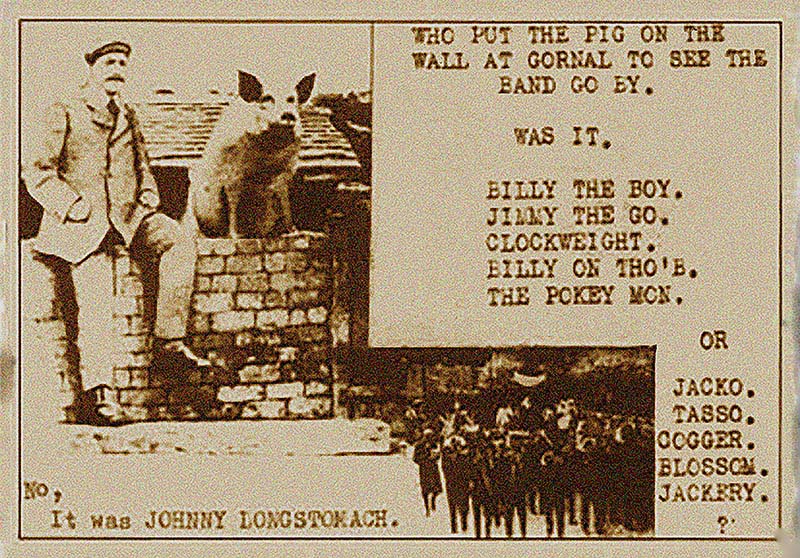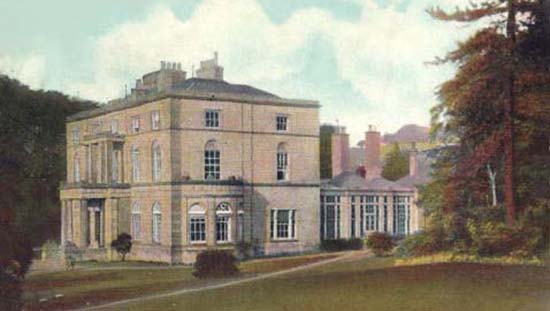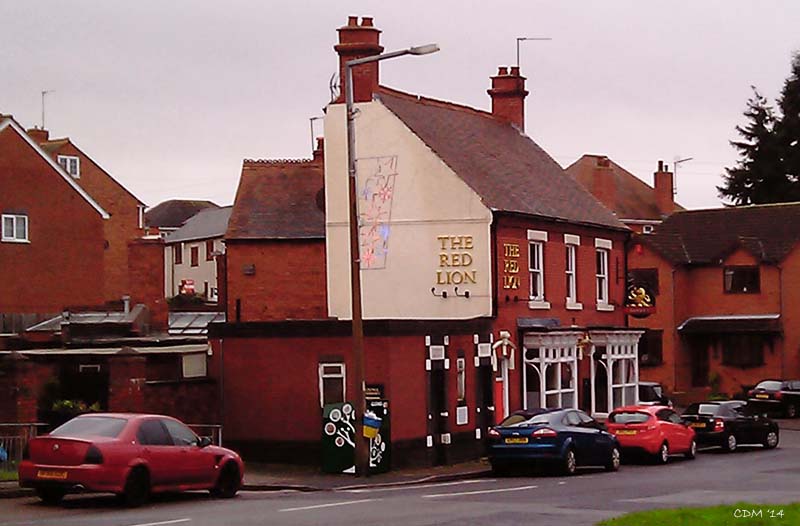
|

|
||
|
Landmarks ~
Churches ~
Pubs ~
Shops ~
Amenities ~
Dwellings ~
Events ~
Schools ~
Sports
Industrial ~ Transport ~ Folklore ~ Families
~ Folklore, Customs and Characters ~
~ Pig On The Wall ~
The Legend of the 'Pig-On-The-Wall'.
Mention Gornal to a Black Countryman, and it won't be long before "where they put the pig-on-the-wall to watch the band go by"
crops up in the conversation.
Perhaps the tale indicates the local humour rather than any simple-mindedness
of the natives, still part of folklore of which Gornal folk are proud,
it's not unusual to spot a statue of a pig adorning someones gatepost.
"Gornal, where they put the pig on the wall to watch the band go by.
Such was the strength of our local legend, the Bricklayers Arms in Kent Street was re-named 'The Pig On The Wall' in 1985 to commemorate it.
 The Gornal version of the postcard.
The Gornal version of the postcard.
The folklore was further perpetuated by a humorous postcard fabricated by Gornal persons unknown.
The Gornal card was based on one which celebrated the cross channel swim of Captain Webb of Dawley, Shropshire in 1875. The original Dawley postcard was produced in 1909, entitled "Who put the Pig on the wall to see Captain Webb's procession pass" and shows a pig poised looking over a wall. This seems to stem from a story published in 1909 about an old women from Ironbridge who "hoisted a pig on the wall of her pig stye to watch the Captain Webb procession", it is said that the same old lady also went out one night with a candle to look for the 'Comet' that was talked about. Make of it what you will!
The Gornal version which was obviously altered later reads:-
"Who put the pig on the wall at Gornal to see the band go by? Was it Billy the Boy, Jimmy the Go, Clockweight, Billy on Tho'b, the Pokey Mon or Jacko, Tasso, Cogger, Blossom, Jackery? No, it was Johnny Longstomach." It was (still is!) common for Gornal folk to be nicknamed in such a manner, some of those mentioned were local legends in their own right.
Gornal and Dawley are not the only places that claim their 'The Pig On The Wall' origins, Droylsden, near Manchester
still has a pub which was named after a similar local legend of the town's folk putting a
pig on a wall to watch the annual carnival procession.
1896: Nuneaton Observer 31 July.
When did it all start?
The earliest reference I found to this folklore in the press is from 1895, "A Somerset yokel put a pig on the wall to enjoy the spectacle of a brass band passing by", it seems that around this time "Who put the pig on the wall" was insulting simple-mindedness, as the newspaper report opposite indicates. Another lighthearted newspaper article entitled "Fool Villages", published in 1901, about "Lamberhead Green", a village near Wigan, the article goes on to say "Another tale told of the village is that people put pigs on the wall to watch the brass bands go past"
There is no doubt that a pig was put on the wall in Gornal at some time in the past and probably more than once, but who copied who?
Some of the characters noted on the spoof Gornal card were associated with the Red Lion Inn in Gornal Wood, the pub would have been central to everything Gornal. Just further along from the Red Lion in Abbey Road was a 'wall' bordering an enclosure owned by Turners, butchers and also a slaughterhouse adjacent, a likely explanation is that one of the above jokers could have put either a pigs head or even a live pig on the wall to watch one of the many processions along Abbey Road.
Whilst others have questioned the validity of the Gornal pig legend and
have offered these alternative explanations, the following version strongly denies any such notion.
The pig (tale) controversy goes on...
This account reproduced with kind permission of Jack Falstaff.
The Village Where They Put The Pig On The Wall To See The Band Go By. Over the years all three Gornals have had this sobriquet attached to them, often in derision, which is a pity - not that any native would take offense, for we have broad backs - but because it all started as our own private in-joke. But that was so long ago that the reality has largely been lost in the mists of time. The Pig on the Wall story is true enough, and it actually happened in Gornal Wood (though less favoured places may wish to lay spurious claims.. but I wouldn't know about that).
The trouble is there are too few natives left to tell the tale, and, of the few there are,
too many have none of the actual facts. It did happen a long time ago, before even my seventy-eight
years began, but here is the story told to me when I was a little lad by a lady,
now long dead, who was actually an eye-witness.
And that's the true story. The proof can be found in a photographic postcard made by the Sedgley Chemist, Mr Eggington, who got the owner of the pig to reconstruct the scene by propping his pig's front feet on the wall for the camera a few days later. Jack Falstaff ~
~
|
|
 *NEW*
*NEW*







